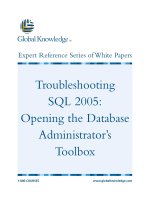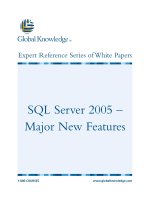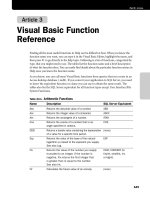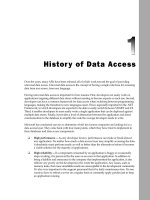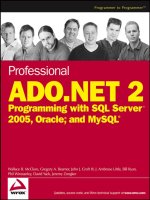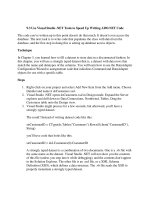Tài liệu Professional VSTO 2005 Visual Studio 2005 Tools for Office docx
Bạn đang xem bản rút gọn của tài liệu. Xem và tải ngay bản đầy đủ của tài liệu tại đây (7.67 MB, 339 trang )
Professional
VSTO 2005
Visual Studio
®
2005
Tools for Office
01_788139 ffirs.qxp 3/29/06 3:00 PM Page i
01_788139 ffirs.qxp 3/29/06 3:00 PM Page ii
Professional
VSTO 2005
Visual Studio
®
2005
Tools for Office
01_788139 ffirs.qxp 3/29/06 3:00 PM Page i
01_788139 ffirs.qxp 3/29/06 3:00 PM Page ii
Professional
VSTO 2005
Visual Studio
®
2005
Tools for Office
Alvin Bruney
01_788139 ffirs.qxp 3/29/06 3:00 PM Page iii
Professional VSTO 2005: Visual Studio®2005 Tools for Office
Published by
Wiley Publishing, Inc.
10475 Crosspoint Boulevard
Indianapolis, IN 46256
www.wiley.com
Copyright © 2006 by Wiley Publishing, Inc., Indianapolis, Indiana
Published simultaneously in Canada
ISBN-13: 978-0-471-78813-3
ISBN-10: 0-471-78813-9
Manufactured in the United States of America
10 9 8 7 6 5 4 3 2 1
1O/RX/QU/QW/IN
Library of Congress Cataloging-in-Publication Data:
Bruney, Alvin, 1971-
Professional Visual studio 2005 tools for Office / Alvin Bruney.
p. cm.
Includes index.
ISBN-13: 978-0-471-78813-3 (paper/website)
ISBN-10: 0-471-78813-9 (paper/website)
1. Microsoft Visual studio. 2. Web site development Computer programs. 3. Microsoft Office. I. Title.
TK5105.8885.M57B786 2006
005.5 dc22
2006005385
No part of this publication may be reproduced, stored in a retrieval system or transmitted in any form or by any
means, electronic, mechanical, photocopying, recording, scanning or otherwise, except as permitted under Sections
107 or 108 of the 1976 United States Copyright Act, without either the prior written permission of the Publisher, or
authorization through payment of the appropriate per-copy fee to the Copyright Clearance Center, 222 Rosewood
Drive, Danvers, MA 01923, (978) 750-8400, fax (978) 646-8600. Requests to the Publisher for permission should be
addressed to the Legal Department, Wiley Publishing, Inc., 10475 Crosspoint Blvd., Indianapolis, IN 46256, (317)
572-3447, fax (317) 572-4355, or online at />LIMIT OF LIABILITY/DISCLAIMER OF WARRANTY: THE PUBLISHER AND THE AUTHOR MAKE NO REP-
RESENTATIONS OR WARRANTIES WITH RESPECT TO THE ACCURACY OR COMPLETENESS OF THE CON-
TENTS OF THIS WORK AND SPECIFICALLY DISCLAIM ALL WARRANTIES, INCLUDING WITHOUT
LIMITATION WARRANTIES OF FITNESS FOR A PARTICULAR PURPOSE. NO WARRANTY MAY BE CREATED
OR EXTENDED BY SALES OR PROMOTIONAL MATERIALS. THE ADVICE AND STRATEGIES CONTAINED
HEREIN MAY NOT BE SUITABLE FOR EVERY SITUATION. THIS WORK IS SOLD WITH THE UNDERSTAND-
ING THAT THE PUBLISHER IS NOT ENGAGED IN RENDERING LEGAL, ACCOUNTING, OR OTHER PRO-
FESSIONAL SERVICES. IF PROFESSIONAL ASSISTANCE IS REQUIRED, THE SERVICES OF A COMPETENT
PROFESSIONAL PERSON SHOULD BE SOUGHT. NEITHER THE PUBLISHER NOR THE AUTHOR SHALL BE
LIABLE FOR DAMAGES ARISING HEREFROM. THE FACT THAT AN ORGANIZATION OR WEBSITE IS
REFERRED TO IN THIS WORK AS A CITATION AND/OR A POTENTIAL SOURCE OF FURTHER INFORMA-
TION DOES NOT MEAN THAT THE AUTHOR OR THE PUBLISHER ENDORSES THE INFORMATION THE
ORGANIZATION OR WEBSITE MAY PROVIDE OR RECOMMENDATIONS IT MAY MAKE. FURTHER, READ-
ERS SHOULD BE AWARE THAT INTERNET WEBSITES LISTED IN THIS WORK MAY HAVE CHANGED OR
DISAPPEARED BETWEEN WHEN THIS WORK WAS WRITTEN AND WHEN IT IS READ.
For general information on our other products and services please contact our Customer Care Department within
the United States at (800) 762-2974, outside the United States at (317) 572-3993 or fax (317) 572-4002.
Trademarks: Wiley, the Wiley logo, Wrox, the Wrox logo, Programmer to Programmer, and related trade dress are
trademarks or registered trademarks of John Wiley & Sons, Inc. and/or its affiliates, in the United States and other
countries, and may not be used without written permission. Visual Studio is a registered trademark of Microsoft Cor-
poration in the United States and/or other countries. All other trademarks are the property of their respective own-
ers. Wiley Publishing, Inc., is not associated with any product or vendor mentioned in this book.
Wiley also publishes its books in a variety of electronic formats. Some content that appears in print may not be
available in electronic books.
01_788139 ffirs.qxp 3/29/06 3:00 PM Page iv
About the Author
Alvin Bruney is a senior software engineer for Indigo Books and Music. His previous development jobs
included spearheading the .NET architecture for NetworkIP, a telecommunications provider, and as a
programmer with Intuit. He self-published a book on Office Web Components, and frequently writes
articles for ASP.NET Professional magazine, MSDN, and other online venues. He is also a Microsoft .NET
MVP and is well known in the 10 newsgroups he monitors.
01_788139 ffirs.qxp 3/29/06 3:00 PM Page v
01_788139 ffirs.qxp 3/29/06 3:00 PM Page vi
Credits
Senior Acquisitions Editor
Jim Minatel
Development Editor
Brian MacDonald
Technical Editors
Jay B. Harlow
Phred Menyhert
Production Editor
Pamela Hanley
Copy Editor
Foxxe Editorial Services
Editorial Manager
Mary Beth Wakefield
Production Manager
Tim Tate
Vice President and Executive Group Publisher
Richard Swadley
Vice President and Executive Publisher
Joseph B. Wikert
Quality Control Technicians
John Greenough
Charles Spencer
Brian H. Walls
Graphics and Production Specialists
Denny Hager
Barbara Moore
Alicia B. South
Proofreading and Indexing
Techbooks
01_788139 ffirs.qxp 3/29/06 3:00 PM Page vii
Kathy, thanks for being there for me all the time.
Boobie tube, you aren’t old enough to read this yet, but I love you.
01_788139 ffirs.qxp 3/29/06 3:00 PM Page viii
Acknowledgments
Thanks to the staff of Wiley for believing in this project and having the discipline to see it through. Thanks to
my family for putting up with the anxious moments and erratic behavior. It was worth it. Thanks to the One
for the energy to pull this one off.
01_788139 ffirs.qxp 3/29/06 3:00 PM Page ix
01_788139 ffirs.qxp 3/29/06 3:00 PM Page x
Contents
Acknowledgments ix
Introduction xvii
Chapter 1: Visual Studio Tools for Office 1
What’s New in VSTO? 1
VSTO Architecture 2
User Interface 3
Client Interface 3
Server Component 3
The VSTO Package 4
About Microsoft Office PIAs 5
System Requirements 6
Alternatives to the VSTO Office Systems 7
VBA 7
Office Web Components 8
Excel COM Interop Libraries 8
Third Party Products 9
Disadvantages of VSTO 9
.NET Framework Required 9
Security 9
Performance 10
VSTO Automation 10
Office XML Schemas 11
Installation and deployment 11
Creating VSTO Projects 13
VSTO Installation Issues 16
Summary 17
Chapter 2: Excel Automation 19
Excel Data Manipulation 19
Design-Time Data Loads 20
Loading Files at Runtime 21
Application Object Manipulation 30
Workbook Manipulation 31
Worksheet Manipulation 32
02_788139 ftoc.qxp 3/29/06 3:01 PM Page xi
xii
Contents
Excel Range Manipulation 34
Working with Named Ranges 35
Working with Cells 37
Working with Unions 38
Working with Intersections 39
Working with Offsets 40
Data Formatting and Presentation 42
Considerations for Excel Automation 44
Excel Case Study — Time Sheet Software 45
Summary 52
Chapter 3: Advanced Excel Automation 55
VSTO Security 55
Workbook Password Protection 55
Worksheet Security 57
Protection through Hidden Worksheets 60
Protecting Ranges 61
VSTO Security through the .NET Framework 62
Working with Excel Formulas 66
Using Formulas at Design Time 66
Using Formulas at Runtime 68
Working with the WorksheetFunctions Method 69
Excel Spreadsheet Error Values 69
Responding to Events 71
Working with Workbook Controls 74
The Range Control 75
The List Control 76
The Actions Pane 78
Printing Workbook Data 80
Excel Toolbar Customization 82
Excel Menu Customization 85
VSTO and Web services 89
Excel Server Automation 95
Excel COM Add-Ins 101
Summary 104
Chapter 4: Word Automation 107
Key Application Objects in Word 107
ThisApplication Instance 108
Working with the Range Object 109
Working with the Bookmark Object 112
02_788139 ftoc.qxp 3/29/06 3:01 PM Page xii
xiii
Contents
Working with the Selection Object 114
VSTO Table Manipulation 115
Working with Documents 119
Manipulating Office Documents 120
Working with Word Templates 123
Toolbar Customization 126
Menu Customization 131
Working with Other Office Applications 134
A PowerPoint Automation Example 134
An Office Automation Executable Example 137
A Smart Tag Example 139
Manipulating Office Controls 143
Word Event Model 147
Printing Documents from Word 149
Considerations for Word Development 149
PIAs and RCWs for Office Word 149
Assemblies and Deployment 150
Custom Actions Panes 150
Summary 151
Chapter 5: Outlook Automation 153
Configuring VSTO Outlook 154
Key Outlook Objects 157
What Is MAPI? 157
Application Object 158
Explorer Object 158
Inspector Object 159
Email Integration 161
Creating Emails 161
Manipulating Email Messages 163
Appointments and Meetings 165
Creating and Scheduling Appointments 165
Deleting Appointments 170
Creating Meetings 172
Creating and Scheduling Outlook Items 173
Folder Manipulation 176
Address Book Manipulation 177
Events 180
Data Manipulation 183
Searching for Data 184
Advanced Data Search 187
Object Model Guard 190
02_788139 ftoc.qxp 3/29/06 3:01 PM Page xiii
xiv
Contents
Working with Office Controls 191
Toolbar Customization 192
Menu Customization 195
Integrating Windows Applications with Outlook 198
Summary 206
Chapter 6: The Charting Tool 209
Design-Time Charting 209
Chart Wizard 210
Charting Nomenclature 211
Creating VSTO Charts 219
Stand-Alone Charts 219
Embedded Charts 220
Loading Charts with Data 221
Essential Chart Object Hierarchy 226
Series Manipulation 226
Axes and Scaling 226
Tick Marks 228
Titles and Captions 232
Chart Groups 234
Formatting Chart Data 236
Font Object Customizations 237
Number Format Customization 238
Chart Surface Customization 240
Chart Legend Manipulation 242
Analysing Data 245
Trending through Trend Lines 246
Internally Supported Trendlines 246
Custom Trendlines 248
Error Bar Analysis 250
Chart Customization through Events 251
Advanced Chart Manipulation 254
Charts with Multiple Series 254
Combination Charts 256
Perspectives and 3-D Drawing 258
Chart Point Customization 260
Adding Objects to the Chart Surface 265
Charts with Special Needs 268
Chart Limitations 271
Summary 272
02_788139 ftoc.qxp 3/29/06 3:01 PM Page xiv
xv
Contents
Chapter 7: Pivot Table Automation 273
Design-Time Pivoting 274
VSTO PivotTable Wizard 275
Pivoting and Drilling 277
Pivot Table Terminology 278
PivotCache Object 279
PivotData Objects 279
Pivot Axis 279
Pivot Fields 280
Pivot Cell Object 280
Pivot Labels 281
Creating Pivot Tables through Code 281
Formatting Pivot Data 285
Font Object Customizations 285
Label Format Customization 286
Style Object Customization 287
Data Formatting with NumberFormats 289
Pivot Axis Iteration 290
Pivot Filtering 292
Adding Miscellaneous Columns 293
Pivot Table Events 294
Creating Pivot Charts 295
Pivot Table Limitations 297
Summary 298
Index 299
02_788139 ftoc.qxp 3/29/06 3:01 PM Page xv
02_788139 ftoc.qxp 3/29/06 3:01 PM Page xvi
Introduction
Visual Studio Tools for Office (VSTO) grew out of a need to write enterprise software based on Office
technology. The book chooses to satisfy this need from a practical perspective. Therefore, the book is
focused on delivering practical solutions for those seeking to port existing functionality to VSTO. Where
necessary, however, the book injects a healthy dose of theory so that developers can learn to think and
feel in this new technology.
The book is especially written for enterprise developers, the VBA or COM Interop savvy—who need to
leverage the power and productivity of VSTO today. .NET developers seeking to explore VSTO as a
potential solution will also find ample material that suits their needs. Even if you are not at all familiar
with VSTO, the book is designed to build your knowledge in this new technology, working first with
simple concepts on up to more involved strategies and solutions for enterprise software.
Who This Book Is For
This book is written for developers who are considering adopting VSTO as an enterprise solution. The
book assumes that you are familiar with object-oriented concepts. The book also assumes that you are
familiar with Visual Studio .NET. However, knowledge of Visual Studio .NET is not necessarily a
requirement.
For the most part, the technical language in the book is mild to moderate. Concepts are presented from a
coding perspective targeting intermediate to advanced developers. The material is presented in such a
way that it serves to encourage non NET programmers. The language and focus of the examples are not
intimidating and have been specifically refined to encourage learning.
The book adopts a code-first approach to satisfy VBA and COM Interop developers. The code to implement
common programming tasks possesses a premium above the theory behind the requirement. For the most
part, developers seeking to port functionality from VBA to VSTO are less interested in the why and more
interested in the how. This book caters wholly to this school of thought.
If you find yourself already comfortable with core concepts, then you may benefit from reading the latter
chapters. Even if you are a seasoned developer, you will still find a lot of useful techniques and strate-
gies for solving enterprise-level software problems from an Office perspective.
What This Book Covers
This book covers VSTO 2005 in detail. The approach focuses on the major components that form the
suite. One exception is that InfoPath is not covered. All other components benefit from an exploration of
the key objects that are most likely to be used in common programming scenarios. Once the basics are
out of the way, the material covers common programming requirements from a practical perspective.
03_788139 flast.qxp 3/29/06 3:02 PM Page xvii
xviii
Introduction
This book is not a discourse in theory. The emphasis is on code. Code is presented in both Visual Basic
and C# with no bias toward either. However, the code is always explained with a dose of theory when
needed. Toward the end of each chapter, the book dives into wider strategies for common problems.
VSTO 2005 is a well-oiled machine, but too often, the focus of this new technology has been on Excel and
Outlook. While this book offers complete coverage of these objects, it also presents the lesser-known
parts of VSTO, including pivot tables and charts. For instance, there are many companies developing
applications based on VSTO while using third-party charting products. VSTO contains a potent charting
engine second to none. And this book explores every facet of charting.
While you may certainly apply techniques learned in this book to Visual Studio Tools for Office 2003,
that is not the intent of this book. For the most part, Visual Studio Tools for Office 2005 has undergone
drastic changes that really separate it from its predecessor.
How This Book Is Structured
This book is organized into chapters that present the building blocks of VSTO first. Microsoft Excel and
its
Range objects form the cornerstone of range manipulation across the VSTO suite. For that reason, the
first few chapters explain these basic concepts. Subsequent chapters use these building blocks as a start-
ing point, so it is important to be familiar with these concepts before skipping to the back of the book.
Once you gain a complete understanding of the Excel
Range object in Chapters 2 and 3, you can apply
that knowledge to the remaining chapters. In fact, Microsoft Word, charts, and pivot table manipulation
are all based on the Excel
Range object. The obvious benefit of this clever architecture is that it signifi-
cantly reduces the learning curve for those who wish to adopt this relatively new technology. And this
book is designed to show you how to exploit this architecture.
What You Need to Use This Book
To compile and run the examples in this book, you will need to install Visual Studio 2005 and Microsoft
Office Professional Edition with Service Pack 1. The Professional Edition is an absolute requirement
because VSTO cannot run without it. However, Visual Studio 2005 is not an absolute requirement. If you
have purchased the stand-alone version of Visual Studio Tools for Office 2005, you do not need Visual
Studio 2005 to compile and run VSTO-based applications.
Conventions
To help you get the most from the text and keep track of what’s happening, we’ve used a number of con-
ventions throughout the book.
Boxes like this one hold important, not-to-be forgotten information that is directly
relevant to the surrounding text.
03_788139 flast.qxp 3/29/06 3:02 PM Page xviii
xix
Introduction
Tips, hints, tricks, and asides to the current discussion are offset and placed in italics like this.
As for styles in the text:
❑ We highlight new terms and important words when we introduce them.
❑ We show keyboard strokes like this: Ctrl+A.
❑ We show file names, URLs, and code within the text like this:
persistence.properties.
❑ We present code in two different ways:
In code examples we highlight new and important code with a gray background.
The gray highlighting is not used for code that’s less important in the present
context or has been shown before.
Source Code
As you work through the examples in this book, you may choose either to type in all the code manually
or to use the source code files that accompany the book. All of the source code used in this book is avail-
able for download at
www.wrox.com. Once at the site, simply locate the book’s title (either by using the
Search box or by using one of the title lists) and click the Download Code link on the book’s detail page
to obtain all the source code for the book.
Because many books have similar titles, you may find it easiest to search by ISBN; this book’s ISBN is
0-471-78813-9.
Once you download the code, just decompress it with your favorite decompression tool. Alternately, you
can go to the main Wrox code download page at
www.wrox.com/dynamic/books/download.aspx to
see the code available for this book and all other Wrox books.
Errata
We make every effort to ensure that there are no errors in the text or in the code. However, no one is per-
fect, and mistakes do occur. If you find an error in one of our books, such as a spelling mistake or faulty
piece of code, we would be very grateful for your feedback. By sending in errata you may save another
reader hours of frustration and at the same time you will be helping us provide even higher-quality
information.
To find the errata page for this book, go to
www.wrox.com and locate the title using the Search box or
one of the title lists. Then, on the book details page, click the Book Errata link. On this page, you can
view all errata that has been submitted for this book and posted by Wrox editors. A complete book list
including links to each book’s errata is also available at
www.wrox.com/misc-
pages/booklist.shtml
.
03_788139 flast.qxp 3/29/06 3:02 PM Page xix
xx
Introduction
If you don’t spot “your” error on the Book Errata page, go to www.wrox.com/contact/techsupport
.shtml
and complete the form there to send us the error you have found. We’ll check the information
and, if appropriate, post a message to the book’s errata page and fix the problem in subsequent editions
of the book.
p2p.wrox.com
For author and peer discussion, join the P2P forums at p2p.wrox.com. The forums are a web-based sys-
tem for you to post messages relating to Wrox books and related technologies and interact with other
readers and technology users. The forums offer a subscription feature to email you topics of interest of
your choosing when new posts are made to the forums. Wrox authors, editors, other industry experts,
and your fellow readers are present on these forums.
At
you will find a number of different forums that will help you not only as you
read this book, but also as you develop your own applications. To join the forums, just follow these steps:
1. Go to p2p.wrox.com and click the Register link.
2. Read the terms of use and click Agree.
3. Complete the required information to join as well as any optional information you wish to pro-
vide, and click Submit.
4. You will receive an e-mail with information describing how to verify your account and com-
plete the joining process.
You can read messages in the forums without joining P2P, but in order to post your own messages, you
must join.
Once you join, you can post new messages and respond to messages other users post. You can read mes-
sages at any time on the Web. If you would like to have new messages from a particular forum emailed
to you, click the Subscribe to this Forum icon by the forum name in the forum listing.
For more information about how to use the Wrox P2P, be sure to read the P2P FAQs for answers to ques-
tions about how the forum software works as well as many common questions specific to P2P and Wrox
books. To read the FAQs, click the FAQ link on any P2P page.
03_788139 flast.qxp 3/29/06 3:02 PM Page xx
Visual Studio Tools
for Office
Visual Studio Tools for Office is the new kid on the block for harnessing the power and functional-
ity of Microsoft Office technology. And Microsoft is investing heavily in getting the word out. The
marketing push forms part of an overall strategy to secure the dominance of Office technology and
Microsoft Office products on the desktop while also providing a solid platform for developing
enterprise level applications based on Microsoft Office technology.
At its core, Visual Studio Tools for Office (VSTO, pronounced “visto”) is simply a platform that
allows Microsoft Office documents to execute code wrapped in a .NET assembly. It is certainly not
the only technology available for developing applications based on Microsoft Office. In fact, web
developers have been using classic ASP and regular COM Interop to build Office based software
for years. But VSTO has been designed to make development of such applications easier and more
reliable than the current approaches available today.
What’s New in VSTO?
VSTO has been completely reworked for .NET 2005. The rework includes tighter integration with
Excel as well as the promotion of native Excel and Word binaries to bona fide .NET objects. These
new objects expose more functionality than what is currently available through the aging
Microsoft Office Application Programming Interface (API). Also, these new .NET objects resolve
many of the memory management issues that plagued the previous Microsoft Office Component
Object Modeler (COM) components.
VSTO sports a new development model, a novel approach to building Office-based applications
that offers significant advantages when compared to previous models. The Classic ASP model that
predates VSTO was based on a platform where content and presentation were mangled together to
construct applications.
04_788139 ch01.qxp 3/29/06 3:02 PM Page 1
One advantage is that there is more room to scale because business logic can be cleanly separated from
the presentation of data. Another advantage is that Office automation can occur on the web application
server in a thread-safe way without the need to write code to adjust the presentation of the data. A third
advantage is that the new model allows executing code to exploit the rich feature set of the .NET
Framework Class Library. The downside, and there always is one, is that these improvements come at
the expense of an increased learning curve, and the need to write code to target a new model.
To help drive the acceptance of VSTO, Microsoft is using the .NET framework as the vehicle to move the
new Office development platform into the midst of the .NET developer population. The marketing strat-
egy is geared toward enticing .NET developers into building applications based on Microsoft Office
technology. Hopefully, if .NET developers find it easy to write Office applications, then they will.
Unfortunately, the marketing picture may not always present the whole story. This book will peel back
the marketing hype baked into Visual Studio Tools for Office to show you what works well and what
does not. The book also intends to show you, in a very practical way, how to build and deliver industrial
strength applications based on Microsoft Office technology. The material in the next few sections will
compare and contrast VSTO with some current approaches for developing Microsoft Office based appli-
cations so you can decide whether or not VSTO is the right tool for the job.
VSTO Architecture
VSTO is not entirely new. The first .NET tool suite appeared with Visual Studio 2003. Before that, savvy
developers simply used COM Interop and Visual Basic for Applications (VBA) to etch out Office based
software. The effort required was considerable due in part to the limitations of the COM based VBA pro-
gramming model. The chosen few who succeeded in building Office applications took on the crown of
“Office Developers”.
Office developers used any means necessary — macros, hacks, Interop — to coax performance and sta-
bility out of these crude, unforgiving environments. Along the way, the approach to building Office
applications got a bad rap because hacks and macros cultivated an environment for malicious software
to flourish even today, embedded macros in applications still cause all sorts of security concerns.
Microsoft is hoping to turn a new page with Visual Studio Tools for Office. VSTO is safer and more
secure than previous technologies used to build Microsoft Office applications. In fact, VSTO can build
fully operational applications without macros.
VSTO.NET addresses the safety and security issues in a couple of ways. Firstly, the new document/view
architecture allows code to be separated from presentation. The code that runs behind the Office docu-
ment can have security restrictions applied to it so that it is guaranteed safe and its authenticity can be
verified before being run. Contrast this to the macro approach where embedded macros are permitted to
execute on the user system unbounded. The new VSTO approach provides developers with more free-
dom to build secure, scalable applications than what was possible before. In that sense, VSTO carves out
new ground, and it does so in a way that eliminates the need to write trick code.
Office 2003 sports a new surface for embedding objects into the document — the actions pane. The
actions pane reduces the effort that is required to host controls on the document surface. Controls can
now be hosted cleanly and efficiently on the document. This new approach leads to well-behaved appli-
cations and side-steps the need to implement hacks to achieve the impossible.
2
Chapter 1
04_788139 ch01.qxp 3/29/06 3:02 PM Page 2


